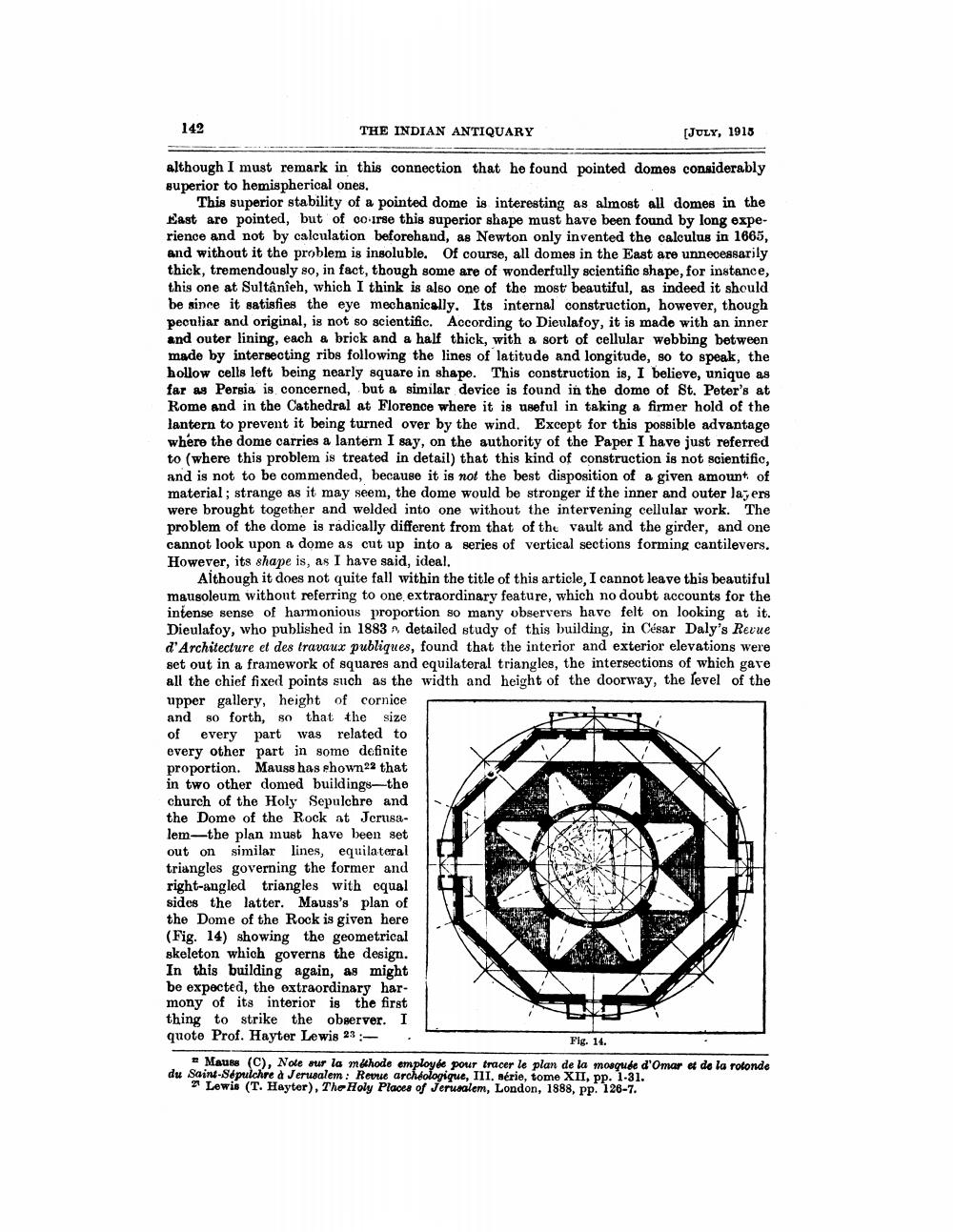________________
142
THE INDIAN ANTIQUARY
[JULY, 1915
although I must remark in this connection that he found pointed domes considerably superior to hemispherical ones.
This superior stability of a pointed dome is interesting as almost all domes in the East are pointed, but of course this superior shape must have been found by long experience and not by calculation beforehand, as Newton only invented the calculus in 1665, and without it the problem is insoluble. Of course, all domes in the East are unnecessarily thick, tremendously so, in fact, though some are of wonderfully scientific shape, for instance, this one at Sultânîeh, which I think is also one of the most beautiful, as indeed it should be since it satisfies the eye mechanically. Its internal construction, however, though peculiar and original, is not so scientific. According to Dieulafoy, it is made with an inner and outer lining, each a brick and a half thick, with a sort of cellular webbing between made by intersecting ribs following the lines of latitude and longitude, so to speak, the hollow cells left being nearly square in shape. This construction is, I believe, unique as far as Persia is concerned, but a similar device is found in the domo of St. Peter's at Rome and in the Cathedral at Florence where it is useful in taking a firmer hold of the lantern to prevent it being turned over by the wind. Except for this possible advantage where the dome carries a lantern I say, on the authority of the Paper I have just referred to (where this problem is treated in detail) that this kind of construction is not scientific, and is not to be commended, because it is not the best disposition of a given amount of material; strange as it may seem, the dome would be stronger if the inner and outer layers were brought together and welded into one without the intervening cellular work. The problem of the dome is radically different from that of the vault and the girder, and one cannot look upon a dome as cut up into a series of vertical sections forming cantilevers. However, its shape is, as I have said, ideal.
Although it does not quite fall within the title of this article, I cannot leave this beautiful mausoleum without referring to one extraordinary feature, which no doubt accounts for the intense sense of harmonious proportion so many observers have felt on looking at it. Dieulafoy, who published in 1883 detailed study of this building, in César Daly's Revue d'Architecture et des travaux publiques, found that the interior and exterior elevations were set out in a framework of squares and equilateral triangles, the intersections of which gave all the chief fixed points such as the width and height of the doorway, the level of the upper gallery, height of cornice and so forth, so that the size of every part was related to every other part in some definite proportion. Mauss has ehown 22 that in two other domed buildings-the church of the Holy Sepulchre and the Dome of the Rock at Jerusalem--the plan must have been set out on similar lines, equilateral triangles governing the former and right-angled triangles with equal sides the latter. Mauss's plan of the Dome of the Rock is given here (Fig. 14) showing the geometrical skeleton which governs the design. In this building again, as might be expected, the extraordinary harmony of its interior is the first thing to strike the observer. I quote Prof. Hayter Lewis 23 :- .
Fig. 14. Mauss (C), Note sur la m ode employée pour tracer le plan de la mosqude d'Omar et de la rotonde du Saint-Sépulchre a Jerusalem : Revue archéologique, I11. série, tome XII, pp. 1.31.
2 Lewis (T. Hayter), The Holy Places of Jerusalem, London, 1888, pp. 126-7.
!
TOR




